Seville orange marmalade is a sweet citrussy preserve made using the juice and peel of oranges. It is delicious served for breakfast on hot toast. It can also be used as a filling for cakes or a topping for ice cream or other desserts.

Once you taste your homemade marmalade I'm sure you will find it was worth spending the time to make it. This marmalade does not contain any unnecessary ingredients, will keep for much longer than shop bought marmalade and tastes better too!
While Seville oranges are ideal for marmalade making other types of oranges such as juicing oranges could be used instead. The good thing about this is that it means you can make this marmalade all year round.
If you are looking for more ideas for homemade preserves take a look at red tomato chutney, mixed fruit chutney, tomato and chilli chutney or red onion chutney.
This orange marmalade recipe will make around 6 to 7 medium sized jam jars.
Ingredients
- 1 kg Seville oranges - Seville oranges are bitter oranges which are ideal for marmalade making as they are high in pectin. If you are unable to get hold of Seville oranges you can substitute another type of bitter orange such as juicing oranges. As the orange peel is going to be used ideally choose organic oranges or lightly scrub before using.
- Juice of 1 lemon - lemon juice will increase the amount of pectin in the jam and help it set.
- 2 kg granulated sugar - there is no need to buy preserving sugar.
- Water - 1.75 litres of water.
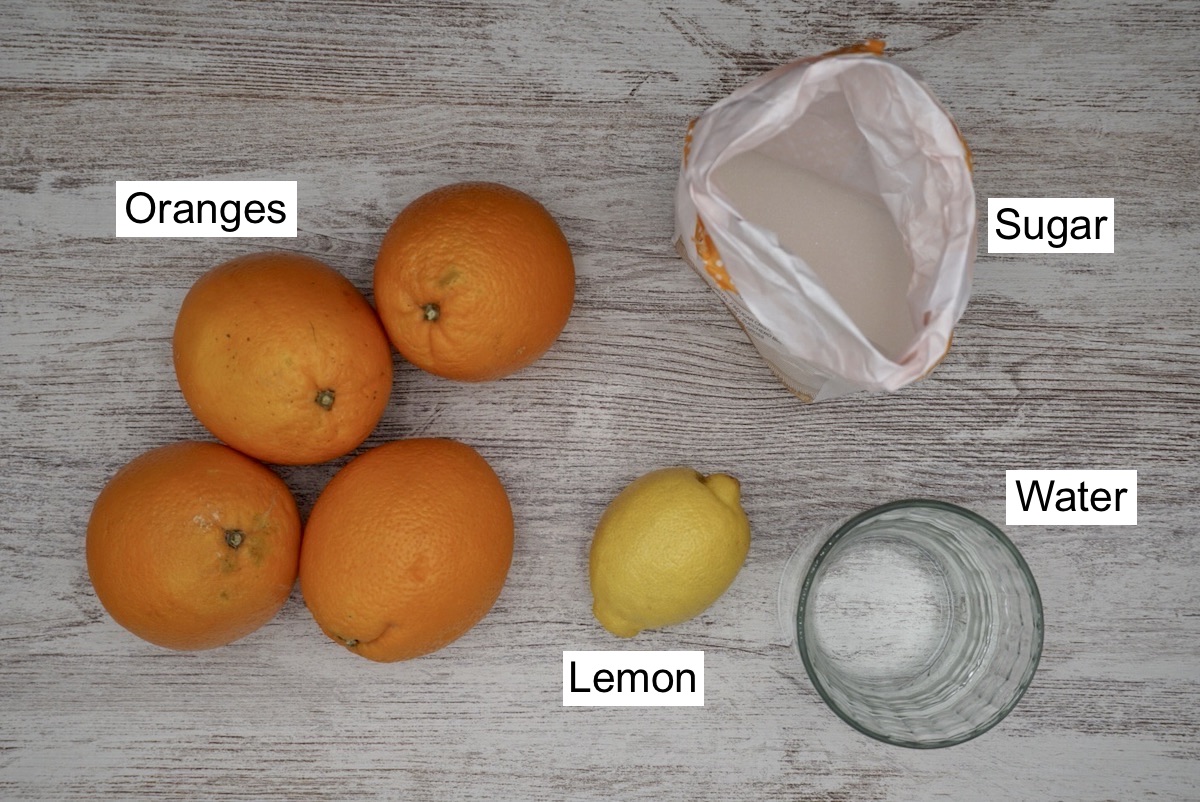
Before starting this recipe
- Place 3 small plates in the freezer. You will use one or more of these to carry out a wrinkle test to check that the marmalade has reached setting point.
- Prepare the jars and lids. See below.
Prepare the oranges
- Lightly scrub the oranges to remove any traces of contaminants.
- Cut the oranges in quarters and remove the insides.
- Squeeze the juice into the pan either by hand or using a juicer.
- Place the orange peel and the segments in a container with 1.75 litres water.
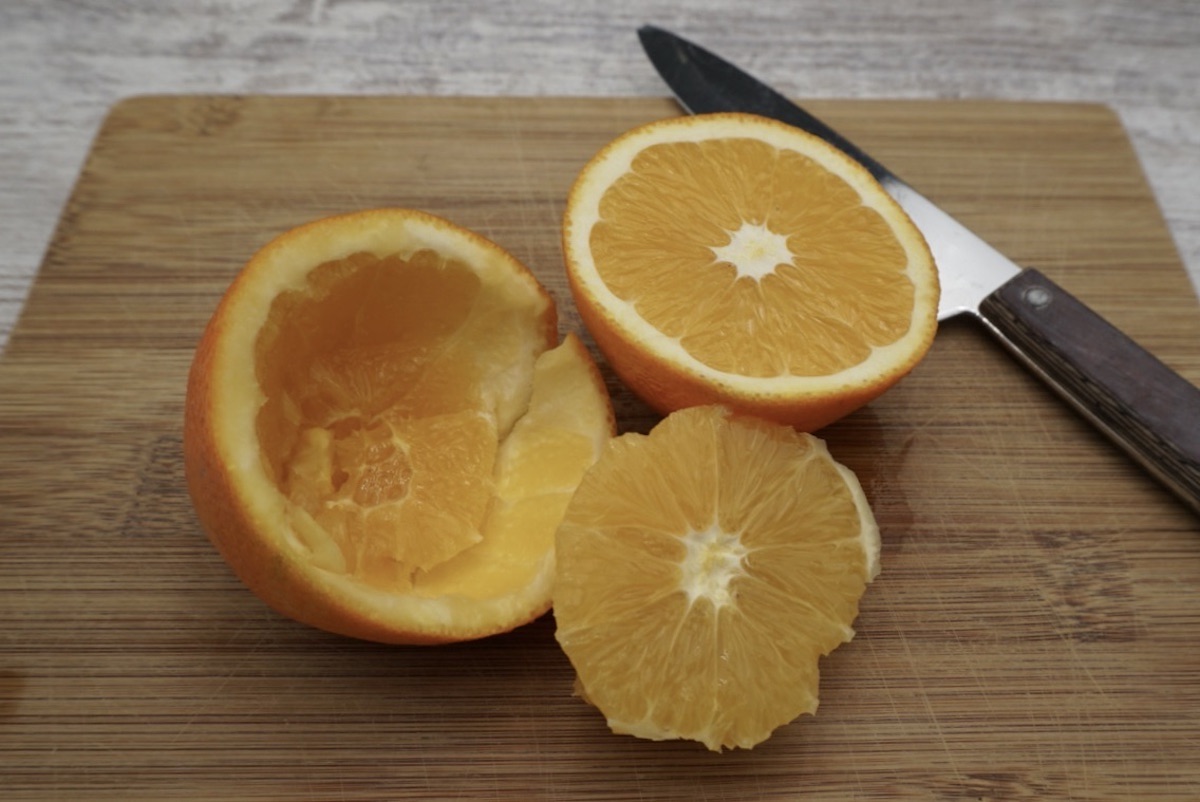
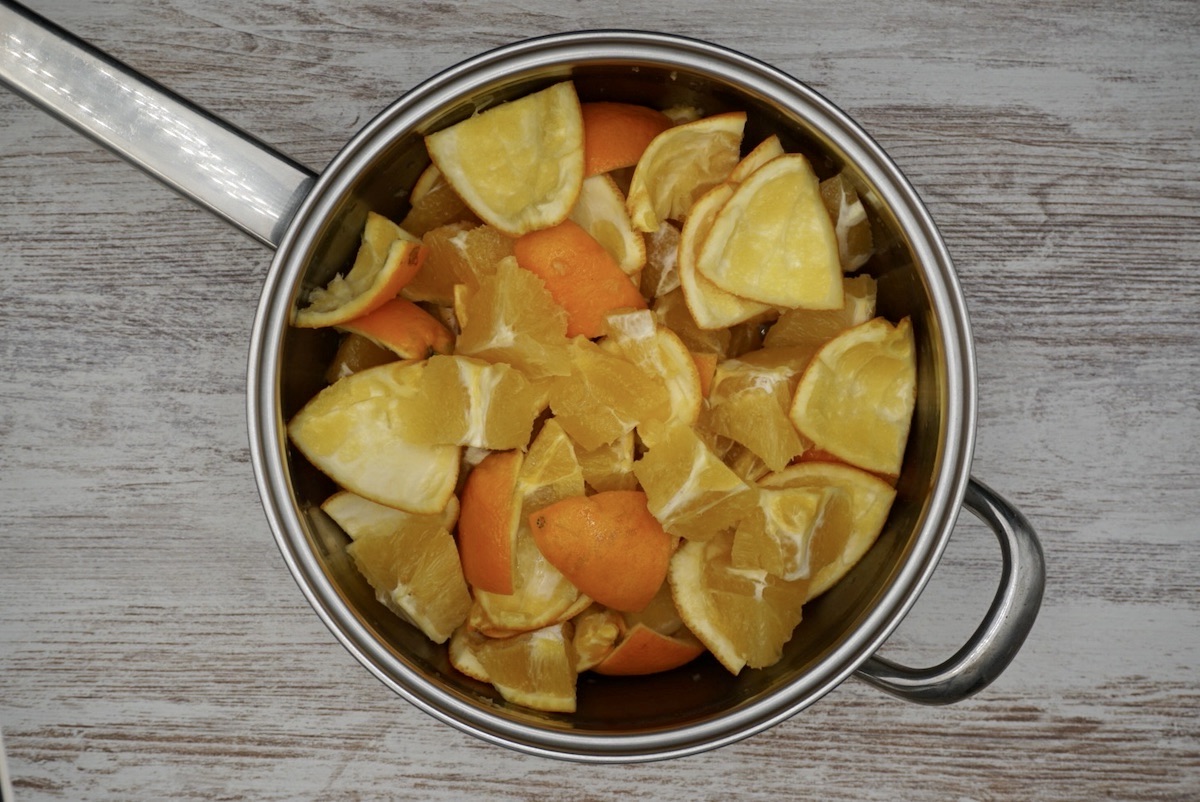
You can proceed to make the marmalade straight away or transfer to a non-metallic bowl and leave to soak overnight. Soaking will help to soften the orange peel, release pectin from the peel and segment casings and reduce the cooking time.
Cook the oranges
Place the cut oranges, insides of the oranges (including the pips) and the water that they have been soaking in in a large pan. Bring to the boil and simmer until the orange peel has softened.
If the orange peel has been left to soak overnight this is likely to take around half an hour or so. If the orange peel is being cooked straight away without soaking then it may take around a couple of hours.
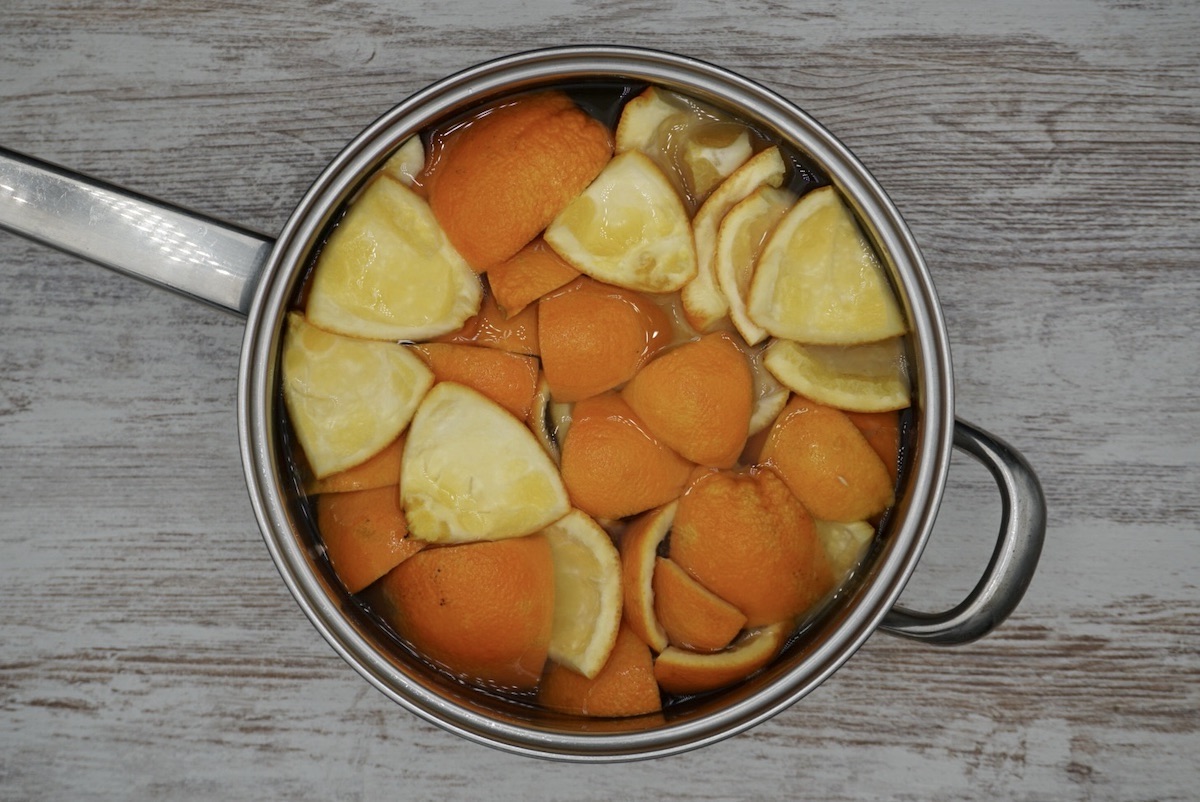
Strain the liquid off and set the liquid aside to reuse. Place the orange peel onto a board ready to cut into shreds.
Squeeze any remaining juice out of the orange segments and discard the solids (insides of the oranges and pips).
Cut the orange peel
Scrape the pith off the inside of the orange peel and cut the peel into small strips using a sharp knife. You can cut the peel either finely or coarsely but ideally cut into uniform lengths and thicknesses for a better appearance.
Cook to setting point
Return the liquid to the pan and add the orange shreds and lemon juice.
Weigh the sugar into an ovenproof dish and heat in the oven at a low setting. The sugar doesn't need to be hot, just warm to the touch so that it will dissolve more quickly when added to the pan.
Add the warmed sugar to the pan with the orange juice and heat gently until the sugar has dissolved. You can check the sugar has fully dissolved by stirring with a wooden spoon and checking to see if any sugar crystals remain.
This is a good time to pop your jars and lids in the oven to sterilise.
Divide into two batches. When boiling the marmalade rapidly the bubbles will rise up the pan. Here I have used a heavy bottomed pan 20cm (8") in diameter and 14cm (5.5") deep and find it works better to carry out the rapid boil in two batches.
Return half the liquid to the heavy bottomed pan and turn up the heat and boil rapidly without a lid for 10 minutes. If you have a sugar thermometer boil at around 104oC to 105oC (220oF to 221oF).
After the marmalade has reached setting point you can repeat with the second batch.
Test for setting point
Carry out a wrinkle test to see whether your marmalade has reached setting point.
Remove the pan from the stove so that the marmalade doesn't continue to cook.
Take one of the plates out of the freezer and remove the pan from the heat. Place a teaspoonful of the marmalade and place it on the plate. When the sample of marmalade has cooled push it with your finger. If the surface wrinkles then setting point has been reached and your marmalade is ready.
If the sample of jam does not wrinkle, return the pan to the heat and boil rapidly for another 5 minutes and then check again. Repeat until setting point is reached.
Leave to cool for around 20 minutes and then transfer to the sterilised jars.
Tips
- Zest the lemon before juicing and save the zest to use in another recipe such as French lemon tart, lemon and poppy seed shortbread, lemon drizzle cake or lemon cheesecake. It is much easier to zest a whole lemon rather than after it has been juiced.
- Make sure the sugar has completely dissolved before turning up the heat for the rapid boil. Undissolved sugar will result in sugar crystals in the finished marmalade.
- Remove the pan from the stove before carrying our the wrinkle test. If the test indicates the marmalade has reached setting point and the marmalade continues to boil it is likely to become overcooked.
- Once setting point is reached leave to cool for around 20 minutes before transferring to the sterilised jars. When the marmalade is hot the shreds will float to the top. As it cools it will become thicker and be able to support the shreds.
- The setting point of marmalade will vary with significant changes in altitude. The Bake School has useful and interesting information on marmalade making including marmalade setting point and is well worth taking a look before you make your batch of marmalade.
How to serve
Your Seville orange marmalade is ready to eat once it has cooled and set.
- Serve on toast for breakfast or a snack.
- Use as a drizzle for cakes such as orange and ginger drizzle cake.
- Stir into rice pudding for extra flavour.
- Use as a topping for ice cream such as straciatella ice cream.
- Drizzle over vegetables while cooking such as roast parsnips or hasselback carrots.
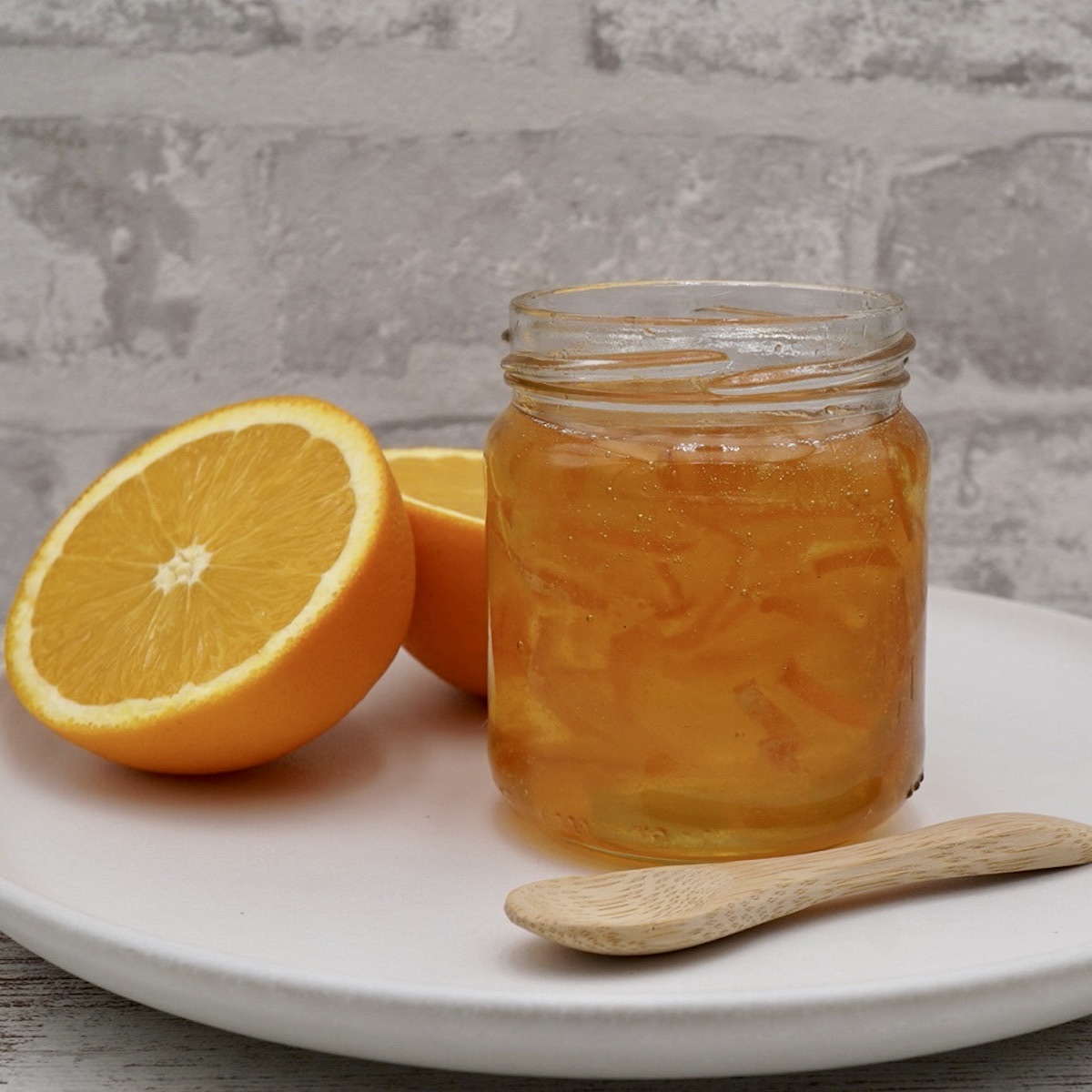
How to store
Store in sterilised jars with tightly fitting lids out of direct sunlight such as in a kitchen cupboard or box. As long as the jars have been properly sterilise it will keep for several months.
How to prepare the jars and lids
You will need around 6 to 7 jars depending on size. It is worth preparing a couple of extra jars just in case they are needed.
- First, check the jars and lids are in a good condition. Discard any lids which show any signs of damage or corrosion and discard any jars with cracked or chipped glass.
- Wash the jars and lids in hot soapy water and dry with clean kitchen paper. Alternatively, the jars and lids can be cleaned in a dishwasher on a hot wash.
- Place the jars (with lids removed) and lids on a baking tray in the oven at a low setting for around 10 to 15 minutes.
- Your jars will now be sterilised and ready to fill with your homemade marmalade.
Other recipes for preserves
- Fig compote using fresh figs20 Minutes
- Easy red tomato chutney1 Hours 30 Minutes
- Persimmon jam with orange and ginger1 Hours 20 Minutes
- Red onion chutney (onion relish)1 Hours 40 Minutes
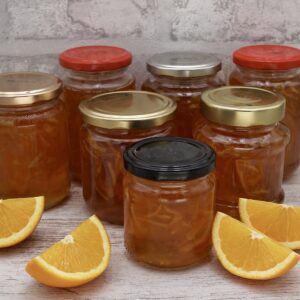

Seville orange marmalade
Ingredients
- 1 kg Seville oranges
- 1 lemon juice
- 2 kg sugar
- 1.75 litres water
Instructions
Prepare the oranges
- Lightly scrub the oranges to remove any traces of contaminants and cut the oranges in quarters and remove the insides. Squeeze the juice into the pan either by hand or using a juicer. Place the orange peel and the segments in a container with 1.75 litres water. Either leave to soak overnight or proceed to make the marmalade.
Cook the oranges
- Place the cut oranges, insides of the oranges (including the pips) and the water that they have been soaking in in a large pan. Bring to the boil and simmer until the orange peel has softened. (Around 30 minutes for oranges soaked overnight. Otherwise around 2 hours).
- Strain the liquid off and set the liquid aside. Place the orange peel onto a board ready to cut into shreds.
- Squeeze any remaining juice out of the orange segments and discard the solids (insides of the oranges and pips).
Cut the orange peel
- Scrape the pith off the inside of the orange peel and cut the peel into small strips using a sharp knife. You can cut the peel either finely or coarsely but ideally cut into uniform lengths and thicknesses for a better appearance.
Cook to setting point
- Return the liquid to the pan and add the orange shreds and lemon juice.
- Weigh the sugar into an ovenproof dish and heat in the oven at a low setting. The sugar doesn't need to be hot, just warm to the touch so that it will dissolve more quickly when added to the pan.
- Add the warmed sugar to the pan with the orange juice and heat gently until the sugar has dissolved. You can check the sugar has fully dissolved by stirring with a wooden spoon and checking to see if any sugar crystals remain.
- This is a good time to pop your jars and lids in the oven to sterilise them.
- Divide into two batches. When boiling the marmalade rapidly the bubbles will rise up the pan. Here I have used a heavy bottomed pan 20cm (8") in diameter and 14cm (5.5") deep and find it works better to carry out the rapid boil in two batches.
- Return half the liquid to the heavy bottomed pan and turn up the heat and boil rapidly without a lid for 10 minutes. If you have a sugar thermometer boil at around 104oC to 105oC (220oF to 221oF).
- After the marmalade has reached setting point you can repeat with the second batch.
Test for setting point
- Remove the pan from the stove so that the marmalade doesn't continue to cook.
- Take one of the plates out of the freezer and remove the pan from the heat. Place a teaspoonful of the marmalade and place it on the plate. When the sample of marmalade has cooled push it with your finger. If the surface wrinkles then setting point has been reached.
- If the sample of jam does not wrinkle, return the pan to the heat and boil rapidly for another 5 minutes and then check again. Repeat until setting point is reached.
- Leave to cool for around 20 minutes and then transfer to the sterilised jars.
Notes
- Zest the lemon before juicing and save the zest to use in another recipe such as French lemon tart, lemon and poppy seed shortbread, lemon drizzle cake or lemon cheesecake.
- Make sure the sugar has completely dissolved before turning up the heat for the rapid boil. Undissolved sugar will result in sugar crystals in the finished marmalade.
- Remove the pan from the stove before carrying our the wrinkle test. If the test indicates the marmalade has reached setting point and the marmalade continues to boil it is likely to become overcooked.
- Once setting point is reached leave to cool for around 20 minutes before transferring to the sterilised jars. When the marmalade is hot the shreds will float to the top. As it cools it will become thicker and be able to support the shreds. As the marmalade cools used a clean utensil to push some of the orange shreds deeper into the marmalade to aim for an even distribution of shreds.
- The setting point of marmalade will vary with significant changes in altitude. The Bake School has useful and interesting information on marmalade making including marmalade setting point and is well worth taking a look before you make your batch of marmalade.
- Serve on toast for breakfast or a snack.
- Use as a drizzle for cakes such as orange and ginger drizzle cake.
- Stir into rice pudding for extra flavour.
- Use as a topping for ice cream such as straciatella ice cream.
- Drizzle over vegetables while cooking such as roast parsnips or hasselback carrots.
Nutrition

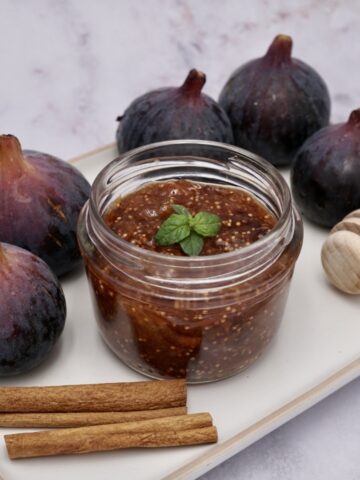
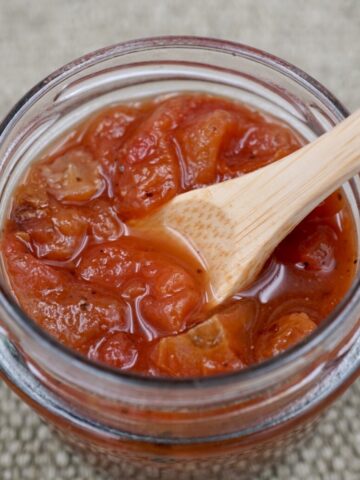
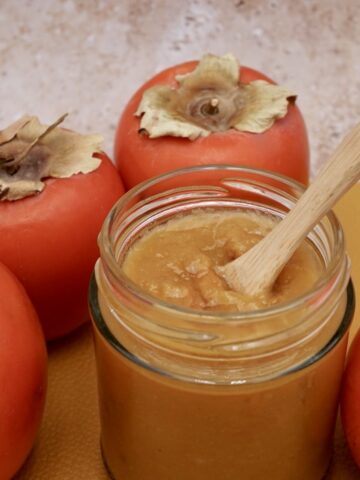





Leave a Reply